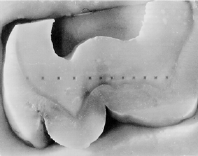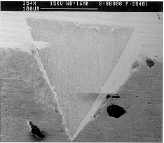Laser Technology in Dentistry
by Gavin Pearson
Work at the Central Microstructure Facility (CMF) at RAL is investigating alternatives to conventional drilling. The Biomaterials Science Department at the Eastman Dental Hospital, and CMF researchers are developing techniques for dental drilling using ultra-violet (UV) lasers.
Dental drills of the sort routinely used today are not that different] from those used a century ago. They rely on an abrasive head, rotating at speeds of 2000 to 300,000 rpm, to grind away the tooth material. The pressure on the tooth coupled with the vibration of the drill often causes some discomfort or even pain. A non-contact method of removing tooth material would take away these problems.
For some time, a few dentists have been using infra-red lasers to cut away soft gum tissue but these have proved unsuitable for cutting tough tooth material. Even at high power these lasers may not cut through the hard tooth and the infra-red wavelength generates a great amount of heat, which may damage the surrounding tissue. Also, when the tooth gets hot, small cracks can appear in the enamel surrounding the drilling. While these appear microscopic, they can mean more fillings are needed at a later date.
 |
Accurate holes cout by laser drilling. |
 |
Laser driling in close-up. |
The Central Microstructure Facility at RAL operates lasers which are normally used to manufacture components for the microelectronics industry. A UV laser can produce very high peak power in bursts lasting less than one hundred millionth of a second. The UV wavelengths used give an efficient drilling process, generating almost no heat. Also UV light can be brought to a sharp focus making it possible to drill shapes of very high precision. Just a few seconds of laser action can cut a perfect pyramid into the tooth, only one fifth of a millimetre across, with no damage to the surrounding tissue. A close up of the laser-drilled surface shows how cleanly the laser cuts through the minute tubes which form the dentine part of the tooth. This level of accuracy could also pave the way to keyhole dentistry. Current techniques remove a large portion of the tooth to get at inner decay. This weakens the tooth considerably, especially if the biting surface is removed. Using lasers, a very small hole could be used to tunnel down to the decay in the tooth, leaving the bulk of the tooth undamaged and much stronger.
Fillings are not a permanent remedy for tooth decay; the common grey amalgam fillings sometimes only last five years, usually because the amalgam shrinks. This leaves an entrance to the inner tooth through which decay causing bacteria can pass. Laser drilling coupled with new ceramic materials could lead to longer lasting and stronger fillings. A filling will also adhere to the clean laser-cut surface better than to a rough abraded surface.
Laser technology has also proved useful in killing the bacteria that cause dental decay. The bacteria appear on the outside of the tooth as a crust of plaque, which the dentist removes with a sharp scraper before a filling is put in. In the case of a laser-drilled tunnel, this would be impossible as the hole is too small. Instead, a special dye which will be taken up by the bacteria can be injected into the tunnel. The dye becomes toxic to the bacteria when it is exposed to the appropriate wavelength of laser light.
Currently, the lasers used in the experimental drilling are huge pieces of equipment. With some development of the hardware, smaller, more easily portable lasers could be developed which would be more suited to the dentist's surgery. Laser techniques have so far been successfully tested on extracted teeth. Once clinical trials are complete, it is likely that laser drilling equipment will start to make an appearance in the high street surgery. In five to ten years, pain-free dentistry may be available to everyone. This work is funded through the Engineering and Physical Sciences Research Council.
Please contact:
Gavin Pearson - Biomaterials Department, Eastman Dental Institute
Tel: +44 171 915 1019
E-mail: G.Pearson@eastman.ucl.ac.uk
